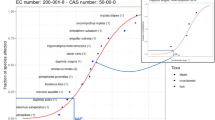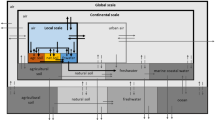Abstract
Purpose
The impact assessment of chemical compounds in Life Cycle Impact Assessment (LCIA) and Environmental Risk Assessment (ERA) requires a vast amount of data on the properties of the chemical compounds being assessed. The purpose of the present study is to explore statistical options for reduction of the data demand associated with characterisation of chemical emissions in LCIA and ERA.
Materials and methods
Based on a USEtox™ characterisation factor set consisting of 3,073 data records, multi-dimensional bilinear models for emission compartment specific fate characterisation of chemical emissions were derived by application of Partial Least Squares Regression. Two sets of meta-models were derived having 63% and 75% of the minimum data demand of the full USEtox™ characterisation model. The meta-models were derived by grouping the dependent variables, the fate factors obtained from the USEtox™ data set and then selecting the independent chemical input parameters from the minimum data set, needed for characterisation in USEtox™, according to general availability, importance and relevance for fate factor prediction.
Results and discussion
Each approach (63% and 75% of the minimum data set needed for characterisation in USEtox™) yielded 66 meta-models. In general, good correlation was obtained between the observed fate factors (those fate factors included in the USEtox™ data set) and the predicted fate factors (those fate factors obtained by the meta-models), and the validation regression coefficients were all in the range (R 2 = 0.41–0.96). The lower end of the regression coefficient range represents those few emission scenarios were the selected independent variables did not contain appropriate information. Hence, most meta-models yielded fate factors in good correlation with the observed fate factors and yielded correlation coefficients in the higher end of the range during validation. In general, the more data-demanding approach yielded the largest regression coefficients.
Conclusions
The applied statistical approach illustrates that it is possible to derive meta-models from full fate and exposure models and that it is also possible to tailor the data demand of these meta-models according to various data and emission preferences. The results obtained in the study reveal that not all emission scenarios included in USEtox™ are exploiting the minimum data set equally and the minimum data set may thus in many cases contain underused data.

Similar content being viewed by others
References
Cronin MTD, Schultz TW (2003) Pitfalls in QSAR. J Mol Struct Theochem 622(1–2):39–51
Esbensen KH (2000) Multivariate data analysis—in practice. Camo ASA, Oslo
European Chemical Bureau (2003) Technical guidance documents in support of Commission directive 96/67/EEC on risk assessment for new notified substances, Commission directive (EC) No. 1488/94 on risk assessment for existing substances, Directive 98/8/EC of the European Parliament and of the Council concerning the placing of biocidal products on the market. Part III. European Commission, Joint Research Centre, Ispra, http://publications.jrc.ec.europa.eu/repository/bitstream/111111111/1212/1/EUR%2019909%20EN.pdf
Huijbregts MAJ, Margni M, Van de Meent D et al. (2010) USEtox™ Chemical-specific database: organics. Report published by the USEtoxTM team. Available upon request at http://www.usetox.org/
ISO (2006) Environmental management—Life cycle assessment—Requirements and guidelines (ISO 14044). International Organization for Standardization, Geneva
Jensen F (2006) Introduction to computational chemistry. Wiley, New York
Martens H, Dardenne P (1998) Validation of regression in small data sets. Chemom Intell Lab Syst 44:99–121
Martens H, Martens M (2001) Multivariate analysis of quality: an introduction. Wiley, New York
OECD (2007) Guidance on the validation of (quantitative) structure-activity relationship [(Q)SAR] models. Organisation for Economic Co-operation and Development, Paris, http://www.oecd.org/officialdocuments/displaydocumentpdf?cote=env/jm/mono(2007)2&doclanguage=en
Rosenbaum RK, Bachmann TM, Gold LS, Huijbregts MAJ, Jolliet O, Juraske R, Koehler A, Larsen HF, Macleod M, Margni M, McKone TE, Payet J, Schumacher M, Van de Meent D, Hauschild MZ (2008) USEtox –the UNEP-SETAC toxicity model: recommended characterisation factors for human toxicity and freshwater Ecotoxicity in LCIA. Int J Life Cycle Assess 13:532–546
Umetrics (2009) SIMPCA-P+, version 12.0.1.0. Umetrics AB, Umeå
US EPA (2009) Estimation Program Interface Suite (EPI Suite), version 4.00. United States Environmental Protection Agency, Washington DC
Wold S, Sjöström M, Eriksson L (2001) PLS-regression: a basic tool for chemometrics. Chemom Intell Lab Syst 58:109–130
Vigneau E, Devaux MF, Qannari EM, Robert P (1997) Principal component regression, ridge regression and ridge principal component regression in spectroscopy calibration. J Chemometr 11:239–249
Acknowledgements
The authors would like to thank Arjan de Koning, Institute of Environmental Sciences, Leiden University and Professor Michael Z. Hauschild, Department of Management Engineering Technical University of Denmark for their support in the initial stages of the study.
Author information
Authors and Affiliations
Corresponding author
Additional information
Responsible editor: Berlan Rodriguez-Perez
Electronicsupplementary materials
Below is the link to the electronic supplementary material.
Appendix
(DOC 8,318 kb)
Rights and permissions
About this article
Cite this article
Birkved, M., Heijungs, R. Simplified fate modelling in respect to ecotoxicological and human toxicological characterisation of emissions of chemical compounds. Int J Life Cycle Assess 16, 739–747 (2011). https://doi.org/10.1007/s11367-011-0281-y
Received:
Accepted:
Published:
Issue Date:
DOI: https://doi.org/10.1007/s11367-011-0281-y




